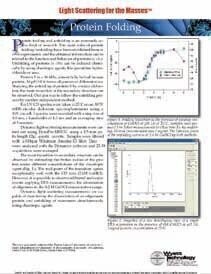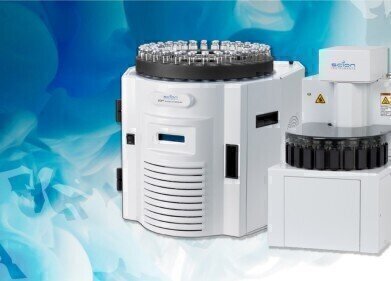Industrial News
New Protein Folding Application Note Uses Wyatt Technology’s Dynamic Light Scattering Technique
Mar 17 2009
SANTA BARBARA, CALIFORNIA (September 15, 2008) – Wyatt Technology, the world leader in absolute macromolecular characterization products, announces the publication of a new, free-of-charge application note
demonstrating the capability of its DynaPro dynamic light scattering instrument to monitor the dissociation of an oligomeric protein and unfolding of monomers simultaneously using chaotropic agents. The analysis of
proteins is particularly important for the study of many diseases such as cancer, diabetes, cardiovascular disease and neurodegenerative diseases such as Alzheimer’s.
The importance of protein folding and unfolding has long been recognized and is an active field of research. The main rules of protein folding/unfolding have been established from in vitro experiments and the information obtained can be related to the function and behavior of proteins in vivo. Unfolding of proteins in vitro can be induced chemically using chaotropic agents like guanidine hydrochloride or urea. Protein Y is a 16 kDa, almost fully helical human protein. At pH 5.0 it forms oligomers of different sizes. Studying the unfolding of protein Y by circular dichroism, the main transition in the secondary structure can be observed. The aim of this specific study was to follow the unfolding process by another independent method.
For this application, far UV CD spectra were taken at 25°C on an AVIV spectrophotometer using a 0.01 cm cell. 5 spectra were recorded with a step size of 1.0 nm, a bandwidth of 1.5 nm and an averaging time of 5 seconds. Samples were prepared 3 hours before measurement to allow time for the unfolding. Protein concentration was 2 mg/ml. The inflexion point of the unfolding curve is at 2.6 M GnHCl by both methods. Dynamic light scattering was performed with a DynaPro using a 12μl quartz cuvette. Samples were filtered with a 0.01μm Whatman Anodisc-13 filter.
Data were analyzed with the easy-to-use Wyatt Dynamics software and 25-30 acquisitions were averaged. The main transition in secondary structure can be observed by estimating the Stokes radius of the protein under different concentrations of the chaotropic agent (Fig. 1.). The mid-point of the transition agrees exceptionally well with the CD data (2.6M GnHCl). However, applying DLS measurements it is possible to observe additional molecular events: the dissociation of oligomers in the 0-2 M GnHCl concentration range.
The results of the experiment clearly demonstrate that dynamic light scattering measurements are capable of quickly and easily monitoring the dissociation of an oligomeric protein and unfolding of monomers
simultaneously using chaotropic agents.
For more information on Wyatt Technology’s DynaPro or to obtain a copy of this application note, please visit www.wyatt.com or e-mail info@wyatt.com
Digital Edition
Chromatography Today - Buyers' Guide 2022
October 2023
In This Edition Modern & Practical Applications - Accelerating ADC Development with Mass Spectrometry - Implementing High-Resolution Ion Mobility into Peptide Mapping Workflows Chromatogr...
View all digital editions
Events
ACS National Meeting - Fall 2024
Aug 18 2024 Denver, CO, USA
Sep 04 2024 Chiba, Tokyo, Japan
Sep 04 2024 University of Warwick, Coventry, UK
Sep 10 2024 Rockville, MD, USA
Plastics Recycling World Expo Europe
Sep 11 2024 Brussels, Belgium














